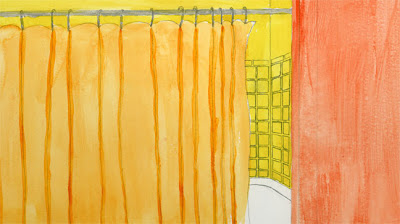I'm currently studying Andrew Loomis's 1943 classic book "Figure Drawing For All It's Worth." I was moving along until I turned to page 30 and saw THIS monstrosity:
Dayum! That's A LOT of information! Moreover, Loomis makes assumptions about our knowledge and therefore doesn't fully explain all of these diagrams.
I went online looking for an explanation of this confusion. Instead I found only more questions. NO ONE had a full explanation as to what was happening on this page.
So I decided to crack the Flat Diagram code myself and can happily say that I think I did it.
The first step is to divide this page into sections. For now, let's focus on this part of the page:
Loomis has divided the figure into an idealized 8 heads tall and 2 1/3 heads wide shown in equally divided boxes. Loomis notes some anatomical points that relate to the box divisions (the female figure's divisions vary slightly, see page 27):
That's pretty clear and self-explanatory. Where the trouble begins is adding perspective to that diagram which Loomis, in my opinion, doesn't fully explain. Here's my approach:
1. Establish your vanishing point. Loomis doesn't show a horizon line in this diagram, but that's on what the vanishing point sits (also known as the viewer's eye line).
2. Draw the width of the figure with a line, here it's A–C. (The dashed lines indicate the extending of the width from that diagram to the new, perspective diagram.)
3. Indicate the midpoint of line A–C with point B.
4. Draw perspective lines from points A, B and C to the vanishing point (NOTE: in the image below, I extended the three perspective lines to the vanishing point. They're not fully shown in the book.)
5. Draw a horizontal to create the first box's depth by "eyeballing" its position. Notice that Loomis labels it "Optional Depth" with an arrow and the number "1".
6. Draw a diagonal line from point A through line B to line C. Where the "Optional depth"/box 1 line meets line B is point D. Where the diagonal meets line C is point E. Loomis labels the diagonal just drawn the "1st diagonal."
7. Point E indicates where the horizontal for box 2 should go. From point E, draw a horizontal to line A. Where this horizontal and line A meet is point H. Also, where box 1's horizontal meets line A is point F. See Loomis's note about the lines.
8. Continue to draw the 2nd and 3rd diagonals. When completed you'll be as far as line G–J and point I. This gives you the first three of eight boxes.
9. Continue the same method of drawing horizontals and diagonals until you have all eight boxes.
10. Now when you place your figure drawing in the perspective diagram/map, according to the original diagram at left, you'll have the figure in correct perspective as shown in these diagrams:
So that's my explanation of the first of Loomis's two ways of rendering the box of the flat diagram.
Tell me if you found this helpful or if any of it is still confusing.
My part II blog post discussing this page will explain the diagram below, the second of the two methods for creating the box:


















































